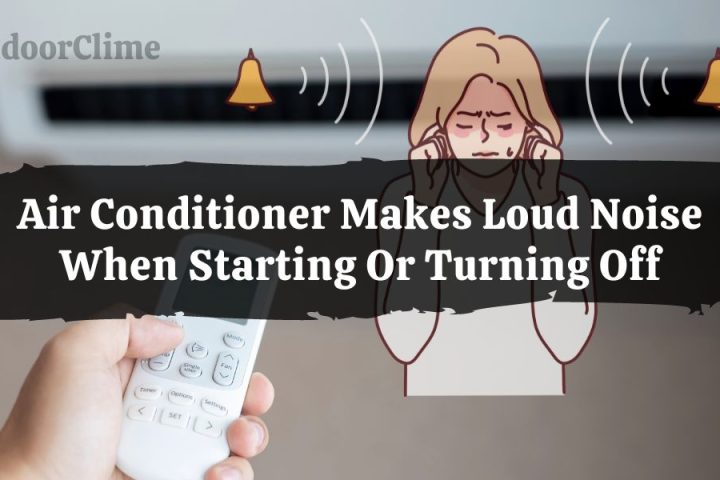In many aspects, a portable air conditioner is comparable to a window air conditioning system. Both are self-contained systems designed to keep a room cool.
Although a portable air conditioner is created to sit within a space rather than dangle from a window, it is also less expensive for house HVAC systems. In addition, they both need to be ventilated to function correctly.
A portable air conditioner has a significant benefit over a window air conditioner because it may be used in rooms with or without windows. It is also easy to go from room to room if you have a window and a vent kit.
Depending on the room’s configuration, there are numerous alternatives for dealing with the hot exhaust air emitted by your system.
You can vent your Portable Air Conditioner through the door, on the ceiling, by the wall, and across a dryer vent. In addition, you can ventilate the hot exhaust air by inserting a pipe through any of the following methods.
Why Do You Need to Vent Your Portable AC?
A portable air conditioner’s objective is to cool a space, but to do so; it must remove heat from the air.
The hot air will remain shut inside the area if the AC unit is not ventilated outside or into another room. It will prevent the room from cooling but also make it hotter.
To work correctly, every portable air conditioner needs a vent. When the AC unit is turned on, it suctions the heated air from your room.
The atmosphere is then cooled and returned to your room. First, the air conditioner will have to exhaust the warm air.
The air conditioner will expel the warm air back into your room if it is not vented, reducing its cooling efficiency. You’ll end up throwing a lot of money into air conditioning.
Venting a portable air conditioner is also crucial since it removes moisture from the air. The cooler a space feels, the less humid it is.
If you don’t vent your portable air conditioner, moisture will build up and negate the air conditioner’s cooling impact.
How to Vent a Portable Air Conditioner With Window?
The most straightforward and typical method of venting your portable air conditioner is through a standard window in your home.
So much so that when you buy a machine, you’ll almost always get free window and venting kits.
Before beginning any installation, make sure you read the instruction manual.
Venting Through Casement Windows
Casement windows aren’t like typical windows in that they open like doors but offer another option for providing ventilation. As a result, you won’t be able to install an exhaust tube with a typical window kit like regular windows.
In essence, you remove one of the window panes and replace it with a layer of Plexiglas, then drill a hole large enough for the exhaust line to pass through. So there you have it, an improvised vent.
Venting Through Sliding Doors and Sliding Windows
In both circumstances, window brackets must be installed to allow for ventilation. However, sliding windows are more challenging to install since the shelf must fit into whatever vent aperture has been built.
You may always use Plexiglas or wood to fill in any gaps that may develop after installation.
How to Vent a Portable Air Conditioner Without a Window?

If you have a room in your house that doesn’t have a window and want an air conditioner, you may use these strategies to vent it without bothering anyone or causing it to underperform.
Vent A Portable AC Unit Through The Door
Most portable air conditioner hose pipes aren’t very long. As a result, you’ll need to position the portable air conditioner near the door.
However, the hose line may not exhaust the heated air outside if situated too far from the door. Thankfully, some portable air conditioners include hose lines that are a little longer.
If you have a pet door in the room and don’t want to put a portable AC close to your door, you can use it to vent the AC unit.
You must, however, ensure that the region around the hose pipe’s entrance is completely sealed. It keeps the warm air from escaping back into your room.
Venting Through a Wall
Using a wall vent to evacuate hot air from a portable air conditioner appears to be one solution that some people favor.
This approach can vent your portable air conditioner outside or into a different room, such as a laundry area, storage room, or garage.
To build a wall vent, you must first carefully cut a hole in the wall large enough to accommodate the exhaust hose from the air conditioner.
After the installation, use a sealant such as silicone caulk to cover the hole’s circle. The exhaust hose will stay in place this way.
Venting Through a Drop-Ceiling
A hole must be cut in the ceiling panel to vent the portable air conditioner to fit the hose. Ensure you’re not interfering with the pipes and electric wires that go through the ceiling panel of your room.
After you’ve formed the hole, feed the hose through it and use silicone sealant to close the remaining gaps.
To guarantee that the heat and humidity levels in the ceiling area are not too high, you must monitor the humidity and temperature in the space. Mold will form in the ceiling space if it is excessively damp.
That’s why the majority of consumers opt for easy-to-install ceiling vent kits. It’s the most practical approach to installing a ceiling hose vent.
Venting Through a Dryer Vent
While using a dryer vent to vent your portable air conditioner is feasible, most manufacturers and experts advise against it.
This is because dryer vents are typically smaller than the exhaust hose on an air conditioner. You’ll have to use force to get the hose into the dryer vent.
Ensure the dryer can efficiently get rid of hot air before attaching the AC’s hose to the dryer’s vent. Otherwise, the heat in the system could build up and spark a fire.
Even after venting the air conditioner through the dryer vent, you should watch it and the dryer to ensure it works correctly.
Do All Portable Air Conditioners Have To Be Vented Out a Window?
If you can find another way to send the heat outdoors, portable air conditioners don’t need to vent through a window.
Instead, you can vent heat directly to a central cooling system through a building’s cold air return ducts, but only if the system can absorb it.
The most common reason to use a portable air conditioner without an outdoor vent is to blow cold air directly on the hottest computer components.
In this case, efficiently lowering the room temperature is not as important as blowing cold air directly on the most desirable computer components.
What Happens If You Don’t Vent a Portable Air Conditioner?
Your portable air conditioner’s function is to keep your room cool. It must do so by extracting heat from the air in your room.
It cools down when the air conditioner removes the heat from your room’s ambiance. Then, through the vent, the extracted heat leaves your room.
If you don’t vent your portable air conditioner, the heat will stay trapped within your room. As a result, instead of chilling, your space will begin to heat up.
The humidity level will start to rise, negating the cooling impact of your air conditioner.
Your portable air conditioner will eventually consume more energy yet produce no results. Instead, it will begin to heat your space. It is because professionals advise that you should.
Can You Vent Portable AC Into Another Room?
It is conceivable, although not encouraged, to vent a portable air conditioner into another room. However, rejecting hot air in an adjacent room would impair cooling effectiveness because of the significant thermal imbalance and heat transfer through walls and gaps.
In addition, most portable air conditioners’ automatic moisture removal causes excessive humidity in the output area, leading to mold and mildew.
For Example. When your portable air conditioner rejects heat in a neighboring or adjacent room or any other room in your home, the temperature disparity in the house would be even more significant, resulting in increased thermal instability.
The heat transmission rate is related to the temperature difference between the zones. As a result, more heat will escape from the hotter zone into your room, resulting in poor cooling efficiency.
To put it another way, less cooling, higher power consumption, and more time are required to achieve the same level of cooling.
The inefficiency of the process is the primary reason why this is not recommended. When you place your portable air conditioner in a different room of your house, it’s still on the premises.
Can You Vent a Portable Air Conditioner Through a Screen?
It is not good to vent a portable air conditioner through a screen. Venting through a screen, in any case, will limit the performance of your portable air conditioner.
But, depending on the current situation, it might be advantageous.
Remove the screen to vent your portable air conditioner through a window. However, in other cases, deleting the screen is not an option.
If you use a screen to vent your portable air conditioner, be sure the screen is clean. A filthy screen will obstruct airflow and impair the performance of your air conditioner.
Can I Use a Portable AC Without an Exhaust Hose?
The simple answer is that you can safely function in a portable air conditioner without a vent hose. However, remember that you should only utilize it in dehumidifier mode because it will heat your room.
If you remove the vent hose, the AC will cycle your room air between cool and dry and hot and humid. Because most units use around 1,000 watts of power, this will heat your room more than cool it down.
The portable ventless evaporative cooler, also known as a portable cooler, is an alternative to a portable air conditioner that doesn’t require large air hoses.
What is a Ventless Portable AC?
A swamp cooler or evaporative air conditioner is another name for a ventless portable air conditioner.
Although it is referred to as an air conditioner, it is not one.
Because a unit must have an external vent connection to dissipate the heat to be classified as an air conditioner (which treats, chills, dehumidifies, and filters the air), this is not the case with ventless portable air conditioners.
These devices are more mechanically similar to a vast swamp cooler, with the added benefit of being able to cool large spaces.
Can You Use a Portable Air Conditioner In a Room With No Windows?
A window isn’t required for portable air conditioners. However, they require some exhaust to remove the hot air as part of the cooling process.
The exhaust hose with the unit is designed to be run through a window. That is the ideal situation. However, this isn’t always achievable.
There are many options to customize your unit to fit any space.
If you have a wall where a hole for a hose may be easily drilled, that’s an alternative; if you have a drop ceiling or access to a ventilation system, that’s also an option.
If you want to chill a room but don’t have a prominent spot to run the exhaust line through, don’t worry; there are alternatives.







